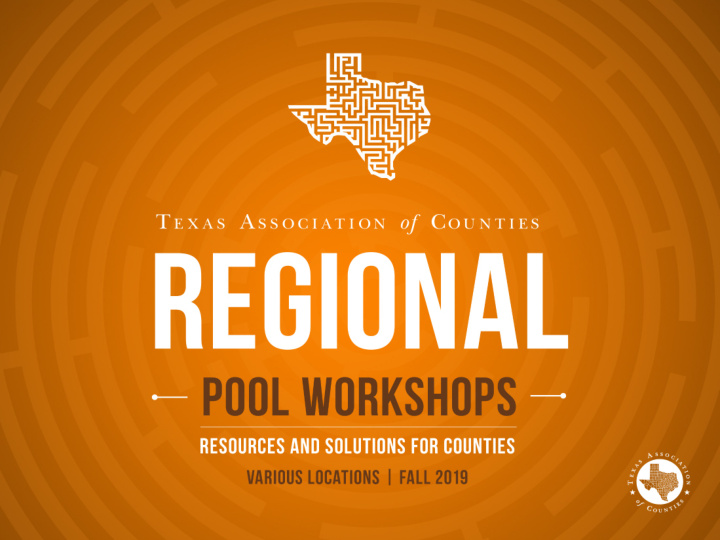



Catastrophe Preparation and Response for Counties Presented by: • Brett Anderson, TAC Property Program Supervisor • Isaac Garcia, TAC Risk Control Consultant
Preparation - Objectives • Define a catastrophe and the all hazards approach. • Discuss planning and preparations that should occur before a catastrophe. • Discuss steps to be taken with the knowledge of an impending catastrophe.
Catastrophic Events
Catastrophic Loss?
Catastrophic Loss?
Catastrophic Loss?
The All Hazards Approach The probability that a specific hazard will impact your county is hard to determine. That’s why it’s important to consider many different threats and hazards and the likelihood they will occur. Plans that may be applied in a variety of situations are the best.
Before Knowledge of Event
Coverage Review • Property • Current list of all county property and areas where county conducts business • Detail locations, building descriptions, contents and occupancy • Consider the possible exposure at the listed properties • Compare list to property coverage schedule • Extra expense coverage • Mobile Equipment & Vehicles • Current list of all MEQ & vehicles • Detail location, value, etc. • Consider MEQ/vehicle demand during event • Compare list to coverage schedule Consult with TAC Risk Management Consultants
Communication, Power and Infrastructure • Primary and secondary base of operations • How will operations be powered? • Satellite Phone • Phone numbers and emails of important personnel • Plan to keep personal digital devices charged
Communication, Power and Infrastructure • Ensure maintenance schedules for essential equipment is followed (generators) • Emergency kits in buildings? • Consider FEMA safe rooms or International Code Council Storm Shelters
Manpower • Consider necessary resources to keep employees safe and ready to work. • Bedding • Restrooms • Food • Water • What else?
Manpower • Many employees will be needing to take care of personal issues in this type of event. • Determine essential employees. • Have a plan to continue necessary clerical functions such as payroll. • Train employees on safe procedures to follow during aftermath. Consult with TAC HR Consultants
Aftermath Planning • Compile list of vendors who can be on stand by • Compile a list of aid resources (other counties, nonprofits, etc.) • Put together teams to handle inspections, claims, and repairs
Site Inspections • Use previously created list • Take precautions on site to minimize damage (clear gutter, clear drains, board windows, etc.) • Consider digital assets - are computers and servers backed up? • Knowledge of relief sites/locations • Should be done at between 12 and 36 hours prior to event
Vehicles and Equipment • Consider where vehicles and equipment are stored • Consider any precautions that should be taken to protect vehicles (covers, relocation, etc.) • Test and repair essential equipment • Fuel?
Employee Training • Brief employees with emergency operations assignments • Review safe operating procedures • Discuss available resources • Discuss chain of command • Safety is of prime importance
Response - Objectives • Discuss actions to take during an event • Discuss immediate actions and evaluations to take place after a catastrophic event • Discuss the claim reporting process which takes place in the days, weeks, and months following an event
During an Event
Emergency Response • Emergency Management Team • Temporary Repairs & 3 rd Party Vendors • Duty to Mitigate Plan Before an Event!
Emergency Management Team • Chain of command • Role of County Judge • Emergency communications
After Event
Execute Plan & Communicate
Emergency Inspections Site & Equipment Inspections Team • Who is on the team? • Safety First!
Duty to Mitigate What does it mean to mitigate damages?
Temporary Repairs
3 rd Party Vendors Emergency response companies • Temporary tarps or board ups • Water & fire/smoke mitigation • Temporary power or office space
3 rd Party Vendors Know the company’s qualifications
Information Team Site Inspections Information • What information is needed? • Who is keeping track of reports? • Who needs to be informed of urgent items? • Does a claim need to be filed?
Claim Team What will the claims team or individuals do?
Reporting a Claim Online Email Portal Fax Phone
The Claim Process – Property Claim Lifecycle
Initial Contact & Inspection Scheduled • What should be discussed? • Who will attend inspections?
Initial Inspection & Estimate Initial Inspection Initial Estimate • Overview of • Estimate is for Property known damages or visible damages at • Photos of damages time of inspection • Measurements of affected areas • Scope of damages
Claims & Repairs Team • Who is monitoring repairs vs claims information? • What should be monitored and communicated? • What about FEMA?
Repairs Completed & Final Payment Repairs are completed for Actual Repairs are completed for Replacement Cash Value (ACV) amount or less Cost Value (RCV) amount Replacement Cost Value RCV is $40,000 is $40,000 Depreciation of $5,000 Depreciation of $5,000 Deductible of $1,000 Deductible of $1,000 ACV Payment of $34,000 ACV Payment of $34,000 Repairs are completed Repairs are completed for $40,000. The $5,000 for $34,000. Is anything depreciation is then else owed? owed.
Understanding Covered vs Non-Covered Is the claim covered wholly, partially or not at all?
Key Points to Remember
Questions?
Property Program Supervisor • Brett Anderson • bretta@couty.org • 512-615-8921 office • 737-221-7494 mobile
Risk Control Consultants Isaac Garcia (512) 573-6596 Jack Coffey, (512) 924-4773 Larry Boccaccio (512) 924-4769 Joseph Szewczyk (512) 815-7869
Recommend
More recommend